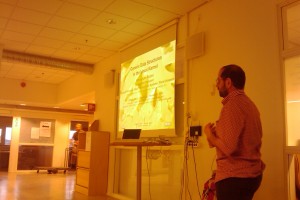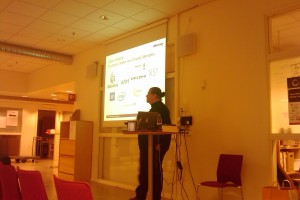07:02: The alarm of my mobile never rang, because I was already up. I got to play with my two kids a while before the taxi arrived to pick me up at 07:30.
The X2000 train from Stockholm to Göteborg took off exactly on schedule and we were off. I learned that the on-board Internet service wasn’t possible to sign on to with Chrome but I had to fire up my good old Firefox for it. Going with first class X2000 offer free Internet all the way, and free coffee. Two of my favorite frees.
The train arrived only 10 minutes late in Gothenburg. I took a taxi over to my hotel, checked in, put my smaller laptop in my backpack and walked over to the FSCONS venue.
After having had lunch and caught up with some friends, I sat down in the big audience listening to the presentation about the Inhana project, by Kyrah. Interactive storytelling and about helping female artists in Syria to play/work with technology in the form av Arduino boards.
Kyrah had the room full. Not that many remained when I entered the stage after her and did my talk on scalable application layer transfers.
I followed up with a cup of coffee after some private discussions on SCTP and how to do fast transfers in the Tor project and then I headed towards the talk about data structures in the Linux kernel by Allesandro Rubini.
Mr Rubini is a long-time involved Linux kernel hacker (and well known co-author of the Linux Device Drivers bible) and in a very casual and effective style he taught us how we can use regular Linux code for lists and trees in a GPL licensed project and how the clever container_of macro works. To me, its biggest drawback is that it relies on a gcc-specific feature: typeof(), but otherwise it is a beautiful craftsmanship.
Allesandro brought down the biggest spontaneous applause when he responded to someone’s question “but couldn’t you also do this using templates in C++?” by suitably and appropriately bashing C++…
Anders Arnholm followed along in the embedded track and he talked about using Linux in the automotive world and I think many of us thought the best part of his talk was the numbers and comparisons he had when trying different flash file systems to increase boot performance and really cut down startup time to a minimum. The initial kernel startup time was 6 something seconds when using JFFS2 and they managed to get down to below 200 milliseconds with the use of the AXFS (Advanced XIP Filesystem, where XIP is short for execute in place).
… after Anders’ talk I followed the crowds, got a seat in a bus and we were transported over to the social event. I mentioned a little bit about that in my previous post, the award for me.
My FSCONS 2010 day 2 entry will be posted within shortly.



